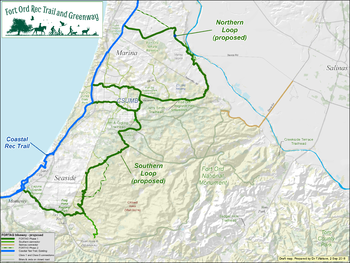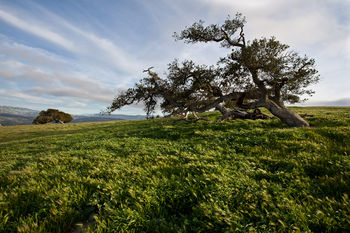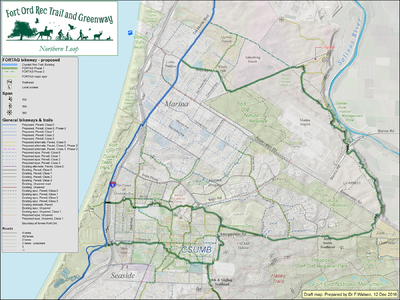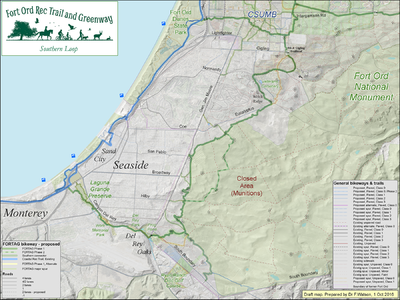Fort Ord Regional Trail and Greenway (FORTAG)
An environmental summary created by the ENVS 560/L Watershed Systems class at CSUMB.

Contents
Summary
The Fort Ord Regional Trail and Greenway (FORTAG) is a proposed 31.7-mile network of paved trails and greenways aimed to better connect communities to open space.[2] The proposed route connects the existing Coastal Rec Trail to the communities of Marina, Seaside and Monterey, creating a streamlined, accessible trail network connecting existing public lands and parks, residential communities, California State University Monterey Bay (CSUMB), Fort Ord National Monument and existing transportation corridors. FORTAG is a grassroots, community conception spearheaded by CSUMB faculty Dr. Scott Waltz and Dr. Fred Watson. The total cost of the project is estimated at $40 million. In November 2016, Monterey County voters approved $20 million in funding for FORTAG as part of the transportation bill Measure X. In February 2018, the TAMC Board approved an additional $1 million in funding and in January 2019 was awarded a $10.3 million grant from the California Transportation Commission, bringing the total current funding for FORTAG to $30.8 million. From November 2019 to January 2020 a Draft Environmental Impact Report was released for a 57-day public review period. Comments received were considered in the Final Environmental Impact Report, which was approved and certified by the TAMC Board in March 2020. [3]
FORTAG is one of several Recreational Planning Initiatives in California's Central Coast Region.
Vision

FORTAG proponents primarily see the trail network as a facilitator of active transportation that expands opportunities for utilizing biking, walking, running, or wheelchairs to commute between home, work, public lands, and commercial areas. Unpaved portions of the trail may be suitable for hikers, mountain bikers, and equestrian travel.
The trail is intended to be "a pleasant and visually obvious route that invites safe use by families with young children on bikes, and that can be jointly used by walkers, joggers, children in strollers, wheelchairs (in key segments), commuter cyclists, and recreational cyclists (including those with narrow tires)."[2]
FORTAG's website lists the following values:
- Connect people to open space
- Be a pleasant experience
- Be useable by anyone
- Have room for everyone
- Be complementary to the built environment
- Have loops, of different sizes
- Be 100% connected all the way around each loop
- Have no 'red flags' from land owners and/or jurisdictions
- Function as a habitat corridor for dispersal of native plants and movement of wildlife (with the exception of certain constrained segments where this is impractical)
Route and details
FORTAG includes three main loops:
- Northern loop: The northern loop of FORTAG follows a 13-mile route around the City of Marina and includes three miles of the existing Coastal Rec Trail.
- Southern loop: The southern loop of FORTAG following a 15-mile route around the City of Seaside and through the City of Del Ray Oaks, and includes four miles of the existing trail system.
- CSUMB loop: A loop through and around CSUMB[2]
| Northern loop | Southern loop |
As proposed, FORTAG will be a 24.2-mile continuous 12-ft wide paved trail with an open space buffer on both sides for most of its length. It will connect to an additional 7.5 miles of existing Monterey Bay Sanctuary Scenic Trail for a total of 31.7 miles. Habitat, parks, playing fields, developed outdoor recreation sites, associated amenities, unpaved trails, and agriculture will be incorporated into the buffer regions. The trail will connect with existing bike/pedestrian infrastructure and plans, as well as provide connections to unpaved trails in the Fort Ord National Monument. Several sections of the paved trail will run loosely parallel to existing unpaved trails. In its current proposed form, FORTAG involves about three road underpasses and one overpass. [3]
History
According to Dr. Scott Waltz, one of the project's founding volunteers, the concept for the project came from the Fort Ord Reuse Authority (FORA)'s call for access to public trails and wildlife corridors as a part of the area's new uses. Along with trail access advocates Dr. Fred Watson, Marina City Councilwoman Gail Morton, and Marina Planning Commissioner Margaret Davis, FORTAG was conceived of in 2013.[5]
Timeline
The events leading up to FORTAG began in 1994 and, as of 2020, are still underway.[6]
- 1994 Fort Ord military base closure
- 1997 Fort Ord Base Reuse Plan adopted
- April 20, 2012 Fort Ord National Monument designated under the Antiquities Act.
- Early 2013 Davis, Morton, Watson and Waltz conceive FORTAG precursor ideas
- Jan 29, 2014 Marina City Council adopts a motion to examine feasibility of a trails/greenways project from Eighth Street to Inter-Garrison.
- 2014 Comprehensive mapping of FORTAG trail concepts
- 2014 Proponents meet and conduct tours with key stakeholders, present FORTAG to community groups including the Monterey Peninsula Regional Park District, FORT Friends, Sierra Club
- November 20, 2014 Morton and Watson present to Marina City Council and Planning Commission. Council adopts a motion to support the concept of FORTAG.
- 2015 Continued meetings, tours and presentations to groups including Sustainable Seaside, Friends of the Fort Ord Warhorse, and Citizens of Sustainable Marina
- August 26, 2015 Presentation to Transportation Agency for Monterey County (TAMC). TAMC unanimously passes motion to work toward FORTAG.
- December 17, 2015 FORTAG presented to Seaside City Council
- Feb. 24. 2016 TAMC Board approves FORTAG to be included included on final list of regional projects to be funded (at $20 million) by TAMC's Transportation Safety and Investment Plan (Measure X), a sales tax to go before voters in November 2016.
- November 8, 2016 General election in which Measure X passes.
- November 30, 2016 FORTAG secures its $20 million in funding from the plan passed by Measure X.
- 2017 - present FORTAG proponents continue meetings, tours and presentations with stakeholders, as well as working to include FORTAG in relevant general plan updates
- March 25, 2017 TAMC Board approves conditional use of additional $900k of TAMC funds as match toward an upcoming application for additional funds through the Federal Lands Access Program (FLAP)
- November 2017 TAMC designated as the Lead Agency for formal scoping and environmental review under CEQA.
- February 2018 TAMC Board approves additional $1 million in state funding for FORTAGand issuance of Request for Proposals for firms to complete FORTAG environmental review and preliminary engineering design.
- August 2018 TAMC Board approves contract to team led by Alta Planning + Design for FORTAG Preliminary Engineering Design & Environmental Review.
- January 2019 $10.3 million in additional state funding secured for FORTAG through a grant awarded to TAMC by the California Transportation Commission.
- November 2019 FORTAG Draft Environmental Impact Report released for a 57-day public review period until January 3, 2020.
- March 25, 2020 TAMC Board certifies the FORTAG Final Environmental Impact Report and is the first agency to approve a Master Agreement to move forward with FORTAG's progress.
Measure X funding
On November 8, 2016, voters passed "Measure X: Monterey County Transportation Agency Sales Tax" with 67.7 percent of the vote. This measure enacts an 0.375 percent sales tax increase for 30 years to fund transportation infrastructure projects. The funding is designated for a variety of transportation infrastructure projects that will:

- Repair potholes and maintain roads
- Improve safety on local roads, highways, and intersections
- Reduce traffic and reduce commute times
- Make walking and biking safer and more accessible
- Protect and enhance public transportation for youth, seniors, and people with disabilities
- Support alternatives to driving that better protect our environment
- Improve safety and traffic flow on highways 68, 101, and 1
- Support safe routes to school and crosswalks[8]
FORTAG will receive an estimated $20 million in funding from Measure X.[9]
Ballot language
"Shall the Transportation Agency for Monterey County fund a transportation safety and investment plan to: improve safety on local roads and highways; repair potholes; maintain streets and roads; reduce traffic congestion; improve transportation for seniors, young people, and people with disabilities; and make walking and biking safer, by enacting a three-eighths percent sales tax, raising approximately twenty million dollars annually over 30 years, plus state and federal matching funds, with citizen oversight and annual independent audits?"
Measure X received endorsements from three major media outlets in Monterey County: the Monterey Herald,[10] the Salinas Californian,[11] and the Monterey County Weekly.[12]
Key stakeholders
FORTAG proponents include a core team of volunteers:
- Dr. Fred Watson: FORTAG proponent & Associate Professor - CSUMB
- Dr. Scott Waltz: FORTAG proponent & Associate Professor - CSUMB & Sierra Club
- Margaret Davis: Friends of the Fort Ord Warhorse & Marina Planning Commissioner
- Gail Morton: Marina City Councilor & Fort Ord Reuse Authority (FORA) Boardmember
The following organizations are involved in or relevant to FORTAG planning and funding:
- TAMC (Transportation Agency for Monterey County)
- City of Seaside
- City of Marina
- City of Del Rey Oaks
- Monterey Peninsula Regional Park District
- City of Monterey
- CSUMB
- BLM (Bureau of Land Management)
- Fort Ord National Monument
- Monterey County
- University of California Fort Ord Natural Reserve
- University of California Monterey Bay Education, Science, and Technology Center
Current progress
Upon completion of FORTAG's Final Environmental Impact Report in March of 2020, TAMC was the first partnering jurisdiction to approve the FORTAG Master Agreement. It is intended that the remaining jurisdictions will follow suit by the summer of 2020. The remaining jurisdictions include: County of Monterey; cities of Seaside, Marina, Monterey, and Del Rey Oaks; California State University Monterey Bay; University of California Santa Cruz; and Monterey Peninsula Regional Park District.
References
- ↑ Fort Ord Rec Trail and Greenway. 2016. Maps. Available from: FORTAG Maps
- ↑ 2.0 2.1 2.2 Fort Ord Rec Trail and Greenway. 2016. Vision. Available from: FORTAG Vision
- ↑ 3.0 3.1 Transportation Agency of Monterey County. 2020. Final Environmental Impact Report. Available from: [1]
- ↑ Fort Ord Rec Trail and Greenway. 2016. Gallery. Available from: FORTAG Gallery
- ↑ Johnson J. 2016. Trail to the Future: Fort Ord Rec Trail and Greenway project aims to connect communities, open space. Available from: Monterey County Herald
- ↑ Fort Ord Rec Trail and Greenway. 2016. Timeline. Available from: FORTAG Timeline
- ↑ BLM California. 2012. Tree in Field at Fort Ord. Available from: Flickr
- ↑ Ballotpedia. 2016. Transportation Agency for Monterey County, California, Sales Tax, Measure X. Available from: Ballotpedia
- ↑ Schmalz D. 2016. Measure X paves way for new trail network from Monterey to Marina. Available from: Monterey County Weekly
- ↑ Unknown author. 2016. Editorial, Oct. 25, 2016: Measure X worth supporting. Available from: Monterey County Herald
- ↑ Eddy M. 2016. Transit measures: No on 53, Yes on X. Available from: The Salinas Californian
- ↑ The Weekly Editorial Board. 2016. Weekly endorsement: Measure X is a vote for a thriving city. Available from: The Monterey County Weekly
Links
- Fort Ord Habitat Conservation Plan (HCP)
- Fort Ord Base Reuse Plan
- Recreational Planning Initiatives in the California Central Coast
- Environmental Planning Initiatives in California's Central Coast
- FORTAG Draft Environmental Impact Report
- FORTAG Final Environmental Impact Report
Disclaimer
This page may contain student work completed as part of assigned coursework. It may not be accurate. It does not necessarily reflect the opinion or policy of CSUMB, its staff, or students.

